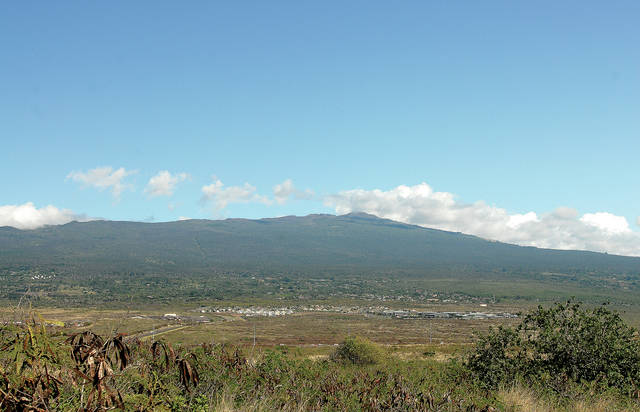KAILUA-KONA — Residents living on the flanks of Hualalai can rest assured that an eruption isn’t coming any time soon.
Still considered an active volcano, the 8,271-foot Hualalai is showing no signs of unrest, said Frank Trusdell, a geologist with the U.S. Geological Survey Hawaiian Volcano Observatory. Indicators that an eruption could loom include increased seismic, or earthquake, activity and deformation, or ground surface changes, that could indicate movement of magma within the volcano.
Scientists currently keep tabs full time on the volcano using seismometers and GPS instruments, and every other year, HVO staff head out to conduct deformation surveys to assess any changes in the ground surface. That’s in addition to daily satellite imagery that can show visual or temperature changes or increased gas emissions.
“So far, there isn’t any reason for us to expend any more effort because the volcano seems quiet,” Trusdell said. “If there is a reason for us to spend more time there we will, but right now, it’s not warranted, therefore you guys can rest assured, those of you who live on the flanks of Hualalai, that, for now, it’s not getting ready to erupt.”
But, Hualalai has erupted three times in the last 1,000 years, and came close, but did not spew lava, during an episode of increased activity in 1929.
Lava last erupted from Hualalai in 1800-01, producing two main flows from the volcano’s northwest rift zone that reached the ocean along the Kona Coast, one of which caused damage.
One flow, the Kaupulehu flow, broke out at about 6,000 feet and flowed to the sea between Kona Village Resort and Kiholo Bay. The other, known as the Hue Hue flow, started around the 500-foot elevation and destroyed several villages, filled in a large fish pond and created the flow field on which Ellison S. Onizuka Kona International Airport is built, according to the observatory.
In 1929, all indicators pointed to an eruption. For about a month in the fall, more than 6,000 earthquakes were recorded, including two magnitude-6.0-plus events. A 6.5-magnitude temblor on Sept. 25 that caused damage to structures. Earthquake frequency ranged from 100 per day to as many as 600 in a 24-hour period.
“The shaking was so intense that people pretty much abandoned their homes in those areas and camped out,” Trusdell said while showing a photo of a voggy campsite set up at Puu Waawaa.
That increased seismic activity was later joined by more signs of eruption.
“Along with the shaking, there actually occurred in one of the ranches — Huehue Ranch to be specific — ground cracks, gas coming out and flames but no red rock,” said Trusdell.
But the activity seemingly stopped there, and scientists term the 1929 episode a failed eruption.
Since, Hualalai’s activity has remained low. On Feb. 6, HVO reported just two earthquakes and no significant deformation during January.

